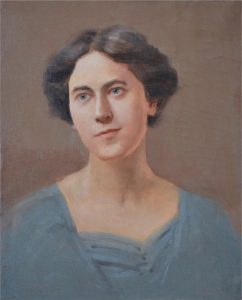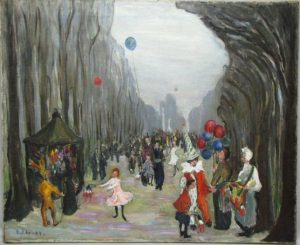“Rose Color to Gold to Glowing Red: Orville and Ethel Peets in Paris 1913-1914”
Historical and Cultural Affairs | Newsroom | Sussex County | Date Posted: Tuesday, February 21, 2017
Historical and Cultural Affairs | Newsroom | Sussex County | Date Posted: Tuesday, February 21, 2017
(DOVER, Del.—Feb. 21, 2017)—The Zwaanendael Museum in Lewes, Del. is currently featuring a new exhibit entitled “Rose Color to Gold to Glowing Red: Orville and Ethel Peets in Paris 1913-1914.” Planned and created by the Delaware Division of Historical and Cultural Affairs, the exhibit features 15 paintings—eight works by Orville Houghton Peets (1884-1968) and seven works by his wife Ethel Canby Peets (1877-1955). Also displayed are an assemblage of painting materials used by the noted Delaware artists including paint brushes and palettes.

Ethel and Orville Peets are credited with bringing fresh, modern ideas to Delaware after their move to Herring Creek near Millsboro in the 1930s. They each influenced the local art-scene in a profound and lasting manner by creating art, teaching classes and holding art forums. Between 2004 and 2007, more than 400 pieces of the couple’s multimedia artwork and artists’ supplies were donated to the collections of the State of Delaware by the Peets’ longtime friends Skipper and Til Purnell.

“Rose Color to Gold to Glowing Red: Orville and Ethel Peets in Paris 1913-1914” opened on Feb. 15, 2017 and will be on display through Dec. 31, 2017 at the Zwaanendael Museum, located at 102 Kings Highway in Lewes, Del. Museum operating-hours from Nov. 1 through March 31 are Wednesdays through Saturdays, 10 a.m. to 4:30 p.m. From April 1 through Oct. 31, museum operating-hours are Tuesdays through Saturdays, 10 a.m. to 4:30 p.m., and Sundays, 1:30 to 4:30 p.m. Admission is free and open to the public. For additional information, call 302-645-1148.
About the artists …
Ethel Poyntell Canby (1877–1955) started her art training at the Clawson S. Hammitt School of Art in Wilmington and became friends with fellow artists Ethel P. Brown and Brown’s future husband William Leach. Canby went on to studies at the Pennsylvania Academy of Fine Arts and, informally, with Howard Pyle in Wilmington. She later travelled to Paris to study at the Académie Moderne and kept a detailed diary of those years. Her work was twice awarded prizes by the Wilmington Society of the Fine Arts and was exhibited at the Baltimore Museum of Art.
Orville Houghton Peets (1884–1968) studied art in Paris at the Académie Julien and the École des Beaux-Arts. He exhibited across the United States and won numerous prizes for his prints and oil paintings. In Delaware, he organized the Wilmington Print Club, taught at the Wilmington Academy of Art, exhibited at the Wilmington Society of the Fine Arts and was a primary artist for the State Portrait Commission for which he was commissioned to paint 14 portraits. His works are in the collections of the Cleveland, Philadelphia and Baltimore museums of art; the University of Delaware; the Rehoboth Art League and the State of Delaware.
Orville was a “Renaissance man” with a wide variety of interests. Among other activities, he taught Spanish conversation classes at the Rehoboth Art League and was an active member of the Sussex Archaeological Society where he served as editor of the organization’s newsletter.
An artistic couple …
Orville Peets met both Ethel Canby and her friend Ethel P. Brown (Leach) in Paris in 1913 and taught them etching techniques. After returning to the United States, Canby and Peets were married on Sept. 23, 1914 shortly after the outbreak of World War I. Orville served in the U.S. Army after America entered the war in 1917. After the conflict, the couple moved back to France, exhibited in various salons and travelled to Portugal in the 1920s. Moving to the art colony of Woodstock, N.Y. around 1930, they became a vital part of the printmaking scene.
By the mid-1930s, Orville and Ethel had moved to the home they called Thorneby on Herring Creek near Millsboro, Del. Both exhibited their art work and volunteered at the Village Improvement Association in Rehoboth Beach. They were instrumental in the founding of the Rehoboth Art League with Louise C. Corkran and their old friend Ethel Leach. Each of them signed the Art League’s “Doors of Fame” at the dedication ceremonies on June 18, 1938, and each continued to exhibit their work and teach at the facility.
The Zwaanendael Museum was built in 1931 to commemorate the 300th anniversary of the state’s first European colony, Swanendael, established by the Dutch along Hoorn Kill (present-day Lewes-Rehoboth Canal) in 1631. Designed by E. William Martin (architect of Legislative Hall and the Hall of Records in Dover), the museum is modeled after the town hall in Hoorn, the Netherlands, and features a stepped facade gable with carved stonework and decorated shutters. The museum’s exhibits and presentations provide a showcase for Lewes-area maritime, military and social history.
-End-
Contact:
Jim Yurasek
Delaware Division of Historical and Cultural Affairs
Phone: 302-736-7413
E-mail: Jim.Yurasek@delaware.gov
Web: http://history.delaware.gov
Keep up to date by receiving a daily digest email, around noon, of current news release posts from state agencies on news.delaware.gov.
Here you can subscribe to future news updates.
Historical and Cultural Affairs | Newsroom | Sussex County | Date Posted: Tuesday, February 21, 2017
(DOVER, Del.—Feb. 21, 2017)—The Zwaanendael Museum in Lewes, Del. is currently featuring a new exhibit entitled “Rose Color to Gold to Glowing Red: Orville and Ethel Peets in Paris 1913-1914.” Planned and created by the Delaware Division of Historical and Cultural Affairs, the exhibit features 15 paintings—eight works by Orville Houghton Peets (1884-1968) and seven works by his wife Ethel Canby Peets (1877-1955). Also displayed are an assemblage of painting materials used by the noted Delaware artists including paint brushes and palettes.

Ethel and Orville Peets are credited with bringing fresh, modern ideas to Delaware after their move to Herring Creek near Millsboro in the 1930s. They each influenced the local art-scene in a profound and lasting manner by creating art, teaching classes and holding art forums. Between 2004 and 2007, more than 400 pieces of the couple’s multimedia artwork and artists’ supplies were donated to the collections of the State of Delaware by the Peets’ longtime friends Skipper and Til Purnell.

“Rose Color to Gold to Glowing Red: Orville and Ethel Peets in Paris 1913-1914” opened on Feb. 15, 2017 and will be on display through Dec. 31, 2017 at the Zwaanendael Museum, located at 102 Kings Highway in Lewes, Del. Museum operating-hours from Nov. 1 through March 31 are Wednesdays through Saturdays, 10 a.m. to 4:30 p.m. From April 1 through Oct. 31, museum operating-hours are Tuesdays through Saturdays, 10 a.m. to 4:30 p.m., and Sundays, 1:30 to 4:30 p.m. Admission is free and open to the public. For additional information, call 302-645-1148.
About the artists …
Ethel Poyntell Canby (1877–1955) started her art training at the Clawson S. Hammitt School of Art in Wilmington and became friends with fellow artists Ethel P. Brown and Brown’s future husband William Leach. Canby went on to studies at the Pennsylvania Academy of Fine Arts and, informally, with Howard Pyle in Wilmington. She later travelled to Paris to study at the Académie Moderne and kept a detailed diary of those years. Her work was twice awarded prizes by the Wilmington Society of the Fine Arts and was exhibited at the Baltimore Museum of Art.
Orville Houghton Peets (1884–1968) studied art in Paris at the Académie Julien and the École des Beaux-Arts. He exhibited across the United States and won numerous prizes for his prints and oil paintings. In Delaware, he organized the Wilmington Print Club, taught at the Wilmington Academy of Art, exhibited at the Wilmington Society of the Fine Arts and was a primary artist for the State Portrait Commission for which he was commissioned to paint 14 portraits. His works are in the collections of the Cleveland, Philadelphia and Baltimore museums of art; the University of Delaware; the Rehoboth Art League and the State of Delaware.
Orville was a “Renaissance man” with a wide variety of interests. Among other activities, he taught Spanish conversation classes at the Rehoboth Art League and was an active member of the Sussex Archaeological Society where he served as editor of the organization’s newsletter.
An artistic couple …
Orville Peets met both Ethel Canby and her friend Ethel P. Brown (Leach) in Paris in 1913 and taught them etching techniques. After returning to the United States, Canby and Peets were married on Sept. 23, 1914 shortly after the outbreak of World War I. Orville served in the U.S. Army after America entered the war in 1917. After the conflict, the couple moved back to France, exhibited in various salons and travelled to Portugal in the 1920s. Moving to the art colony of Woodstock, N.Y. around 1930, they became a vital part of the printmaking scene.
By the mid-1930s, Orville and Ethel had moved to the home they called Thorneby on Herring Creek near Millsboro, Del. Both exhibited their art work and volunteered at the Village Improvement Association in Rehoboth Beach. They were instrumental in the founding of the Rehoboth Art League with Louise C. Corkran and their old friend Ethel Leach. Each of them signed the Art League’s “Doors of Fame” at the dedication ceremonies on June 18, 1938, and each continued to exhibit their work and teach at the facility.
The Zwaanendael Museum was built in 1931 to commemorate the 300th anniversary of the state’s first European colony, Swanendael, established by the Dutch along Hoorn Kill (present-day Lewes-Rehoboth Canal) in 1631. Designed by E. William Martin (architect of Legislative Hall and the Hall of Records in Dover), the museum is modeled after the town hall in Hoorn, the Netherlands, and features a stepped facade gable with carved stonework and decorated shutters. The museum’s exhibits and presentations provide a showcase for Lewes-area maritime, military and social history.
-End-
Contact:
Jim Yurasek
Delaware Division of Historical and Cultural Affairs
Phone: 302-736-7413
E-mail: Jim.Yurasek@delaware.gov
Web: http://history.delaware.gov
Keep up to date by receiving a daily digest email, around noon, of current news release posts from state agencies on news.delaware.gov.
Here you can subscribe to future news updates.